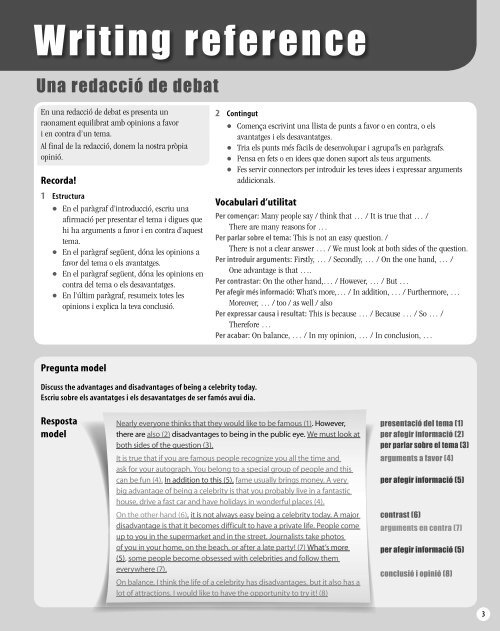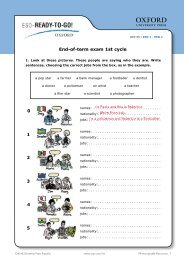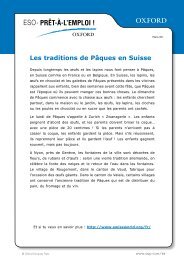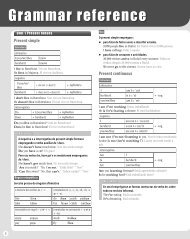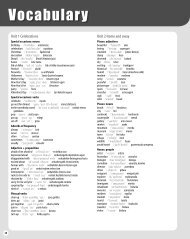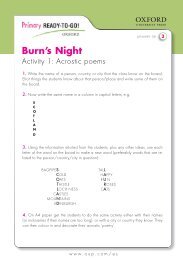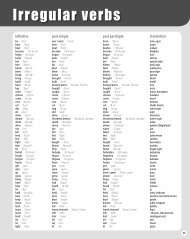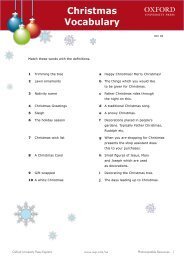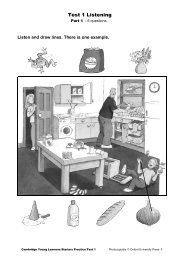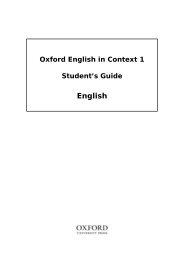cubierta in context catalan 2.indd
cubierta in context catalan 2.indd
cubierta in context catalan 2.indd
Create successful ePaper yourself
Turn your PDF publications into a flip-book with our unique Google optimized e-Paper software.
Writ<strong>in</strong>g reference<br />
Una redacció de debat<br />
En una redacció de debat es presenta un<br />
raonament equilibrat amb op<strong>in</strong>ions a favor<br />
i en contra d’un tema.<br />
Al f<strong>in</strong>al de la redacció, donem la nostra pròpia<br />
op<strong>in</strong>ió.<br />
Recorda!<br />
1 Estructura<br />
• En el paràgraf d’<strong>in</strong>troducció, escriu una<br />
afirmació per presentar el tema i digues que<br />
hi ha arguments a favor i en contra d’aquest<br />
tema.<br />
• En el paràgraf següent, dóna les op<strong>in</strong>ions a<br />
favor del tema o els avantatges.<br />
• En el paràgraf següent, dóna les op<strong>in</strong>ions en<br />
contra del tema o els desavantatges.<br />
• En l’últim paràgraf, resumeix totes les<br />
op<strong>in</strong>ions i explica la teva conclusió.<br />
2 Cont<strong>in</strong>gut<br />
• Comença escriv<strong>in</strong>t una llista de punts a favor o en contra, o els<br />
avantatges i els desavantatges.<br />
Tria els punts més fàcils de desenvolupar i agrupa’ls en paràgrafs.<br />
Pensa en fets o en idees que donen suport als teus arguments.<br />
• Fes servir connectors per <strong>in</strong>troduir les teves idees i expressar arguments<br />
addicionals.<br />
Vocabulari d’utilitat<br />
Per començar: Many people say / th<strong>in</strong>k that … / It is true that … /<br />
There are many reasons for …<br />
Per parlar sobre el tema: This is not an easy question. /<br />
There is not a clear answer … / We must look at both sides of the question.<br />
Per <strong>in</strong>troduir arguments: Firstly, … / Secondly, … / On the one hand, … /<br />
One advantage is that ….<br />
Per contrastar: On the other hand,… / However, … / But …<br />
Per afegir més <strong>in</strong>formació: What’s more,… / In addition, … / Furthermore, …<br />
Moreover, … / too / as well / also<br />
Per expressar causa i resultat: This is because … / Because … / So … /<br />
Therefore …<br />
Per acabar: On balance, … / In my op<strong>in</strong>ion, … / In conclusion, …<br />
Pregunta model<br />
Discuss the advantages and disadvantages of be<strong>in</strong>g a celebrity today.<br />
Escriu sobre els avantatges i els desavantatges de ser famós avui dia.<br />
Resposta<br />
model<br />
Nearly everyone th<strong>in</strong>ks that they would like to be famous (1). However,<br />
there are also (2) disadvantages to be<strong>in</strong>g <strong>in</strong> the public eye. We must look at<br />
both sides of the question (3).<br />
It is true that if you are famous people recognize you all the time and<br />
ask for your autograph. You belong to a special group of people and this<br />
can be fun (4). In addition to this (5), fame usually br<strong>in</strong>gs money. A very<br />
big advantage of be<strong>in</strong>g a celebrity is that you probably live <strong>in</strong> a fantastic<br />
house, drive a fast car and have holidays <strong>in</strong> wonderful places (4).<br />
On the other hand (6), it is not always easy be<strong>in</strong>g a celebrity today. A major<br />
disadvantage is that it becomes difficult to have a private life. People come<br />
up to you <strong>in</strong> the supermarket and <strong>in</strong> the street. Journalists take photos<br />
of you <strong>in</strong> your home, on the beach, or after a late party! (7) What’s more<br />
(5), some people become obsessed with celebrities and follow them<br />
everywhere (7).<br />
On balance, I th<strong>in</strong>k the life of a celebrity has disadvantages, but it also has a<br />
lot of attractions. I would like to have the opportunity to try it! (8)<br />
presentació del tema (1)<br />
per afegir <strong>in</strong>formació (2)<br />
per parlar sobre el tema (3)<br />
arguments a favor (4)<br />
per afegir <strong>in</strong>formació (5)<br />
contrast (6)<br />
arguments en contra (7)<br />
per afegir <strong>in</strong>formació (5)<br />
conclusió i op<strong>in</strong>ió (8)<br />
3
Un diàleg<br />
Un diàleg és una conversa entre dues o més<br />
persones.<br />
Quan escrivim un diàleg, hem de deixar-ne<br />
clara la funció, per exemple, explicar / donar<br />
notícies.<br />
Recorda!<br />
1 Estructura<br />
• Un diàleg té:<br />
- un pr<strong>in</strong>cipi (per deixar clara la funció<br />
de la conversa)<br />
- un nus (l’<strong>in</strong>tercanvi pr<strong>in</strong>cipal)<br />
- un f<strong>in</strong>al (la conclusió)<br />
• Organitza el diàleg clarament perquè<br />
el lector pugui veure fàcilmente qui<br />
parla.<br />
2 Cont<strong>in</strong>gut<br />
Pensa en els personatges i què dirien i farien.<br />
• Fes servir un llenguatge natural i <strong>in</strong>formal, i <strong>in</strong>clou expressions<br />
col·loquials, contraccions, expressions per omplir, verbs amb partícules<br />
i respostes curtes.<br />
Vocabulari d’utilitat<br />
Salutacions: Hi! / How are you? / How’s life? / How are th<strong>in</strong>gs? / F<strong>in</strong>e. / Great. /<br />
Not bad, thanks.<br />
Verbs amb partícules: pick up / put off / drop <strong>in</strong> / pop round / look forward to<br />
Expressions col·loquials: Hiya! / What’s up? / Cool! / Sure. / Sounds good. /<br />
You’re kidd<strong>in</strong>g! / Do you fancy …? / Hang on! / OK.<br />
Expressions per omplir: erm… / umm … / look, … / oh, … / well, …<br />
Comiats: Great to see you. / See you soon. / Say ‘Hi!’ to… for me. /<br />
I’ll be <strong>in</strong> touch. / Bye.<br />
Pregunta model<br />
Write a telephone conversation between two friends mak<strong>in</strong>g arrangements to go to the beach.<br />
Escriu una conversa telefònica entre dos amics que fan plans per anar a la platja.<br />
Resposta model Becky Hello (1). salutacions (1)<br />
Trish Hi (1) Becky! It’s me (1).<br />
Becky Trish, hi! How are th<strong>in</strong>gs? (1)<br />
Trish OK. But I’m (2) so bored. I really want to go contracció (2)<br />
out somewhere and do someth<strong>in</strong>g. Listen (3), are you expressions per omplir (3)<br />
do<strong>in</strong>g anyth<strong>in</strong>g this afternoon?<br />
Becky Nope (4). I’m bored too. There’s no one at expressió col . loquial (4)<br />
home, noth<strong>in</strong>g on TV, and I’ve f<strong>in</strong>ished<br />
all my homework. So, where do you want to go?<br />
Trish Do you fancy go<strong>in</strong>g (4) to the beach? We could give expressió col . loquial (4)<br />
Ben and Jim a r<strong>in</strong>g and f<strong>in</strong>d out if they want to<br />
come. Ben’s got (2) his dad’s car for the weekend too! contracció (2)<br />
Becky Great idea! We could take a picnic and the<br />
volleyball th<strong>in</strong>gs.<br />
Trish Cool! (4) I’ll phone Ben and Jim and expressió col . loquial (4)<br />
we’ll pick you up (5) <strong>in</strong> half an hour. verb amb partícules (5)<br />
Becky Sounds good (4). I’ll make some sandwiches. And expressió col . loquial (4)<br />
don’t (2) forget the suncream! contracció (2)<br />
Trish I won’t! (6) And remember – Ben is a vegetarian! resposta curta (6)<br />
Becky OK. See you <strong>in</strong> half an hour (7). comiat (7)<br />
Trish See you (7).<br />
4
Una narració<br />
En una narració, expliquem una història o un esdeveniment.<br />
La història pot ser real o imag<strong>in</strong>ària.<br />
Normalment, s’hi fan servir temps passats.<br />
Recorda!<br />
1 Estructura<br />
• La història ha de tenir un pr<strong>in</strong>cipi, un nus i un f<strong>in</strong>al<br />
molt clars.<br />
2 Cont<strong>in</strong>gut<br />
• Fes que la teva història sigui tan <strong>in</strong>teressant<br />
i emocionant com puguis.<br />
Parla sobre l’ambient i les teves emocions.<br />
• Fes servir una varietat de verbs, adjectius i adverbis per<br />
afegir <strong>in</strong>terès.<br />
Fes servir diferents temps verbals passats.<br />
• Fes servir mots per expressar la successió dels fets<br />
i connectors per <strong>in</strong>dicar l’ordre dels esdeveniments.<br />
Vocabulari d’utilitat<br />
Per començar: I had never been so excited / happy, etc. /<br />
It was the best / worst day of my life. / It was completely dark! /<br />
I will always remember … / One of my happiest /<br />
worst memories …<br />
Expressions de temps: one day, / last week, / two days ago /<br />
s<strong>in</strong>ce Monday / for a week / at midnight,<br />
Connectors de temps: When … / As soon as … / While …<br />
Per expressar la successió dels fets: Before … / At first, … / Later, …<br />
/ Then … / After that, … / Afterwards, …<br />
Adverbis de manera: angrily / happily / quietly / suddenly<br />
Adverbis de grau: really / very / extremely<br />
Per fer comentaris amb adverbis: amaz<strong>in</strong>gly / luckily /<br />
(un)fortunately<br />
Expressar emocions: surprised / excited / scared / lonely /<br />
worried / happy<br />
Per acabar: In the end,… / Never aga<strong>in</strong>! / What a/an …! /<br />
I hope someth<strong>in</strong>g like that never happens aga<strong>in</strong>!<br />
Pregunta model<br />
Write a story about someth<strong>in</strong>g frighten<strong>in</strong>g that happened on a journey.<br />
Escriu una història sobre alguna cosa aterridora que va passar en un viatge.<br />
Resposta model<br />
It was the most frighten<strong>in</strong>g moment of my life! (1) I was (2) començ <strong>in</strong>teressant (1)<br />
late because I had overslept. I missed (2) my normal tra<strong>in</strong>, temps passats (2)<br />
so I took (2) the 10.00 tra<strong>in</strong> <strong>in</strong>stead. When (3) I got off (2) at connectors de temps (3)<br />
Wyford, I stepped <strong>in</strong>to a real nightmare (4). ambient (4)<br />
I knew (2) someth<strong>in</strong>g was (2) wrong as soon as (3) I started (2)<br />
walk<strong>in</strong>g along the platform. There was (2) a group of people stand<strong>in</strong>g<br />
very (5) still and look<strong>in</strong>g at someth<strong>in</strong>g or someone. When (3)I adverbi de grau (5)<br />
got (2) nearer, I saw (2) that a man and a woman were<br />
stand<strong>in</strong>g (2) outside the ticket office. The man was po<strong>in</strong>t<strong>in</strong>g (2)<br />
a gun at the woman. I was terrified! (6) sentiments (6)<br />
It was so strange. Everyone stopped mov<strong>in</strong>g and watched<br />
the man. It was like a scene from a film (4)! Suddenly (7), two police ambient (4)<br />
officers came up (2) beh<strong>in</strong>d the man and knocked (2) the gun adverbi de manera (7)<br />
out of his hand. Later (3), someone told (2) me that it wasn’t (2) a, seqüència (8)<br />
real gun it was (2) a toy. The man had stolen (2) money from<br />
the ticket office and the woman had tried (2) to stop him.<br />
Fortunately (9), the man was caught and no one was hurt, but comentari amb adverbi (9)<br />
I hope that noth<strong>in</strong>g as frighten<strong>in</strong>g as this ever happens aga<strong>in</strong>! (10) f<strong>in</strong>al (10)<br />
5
Un resum<br />
Escrivim un resum per transmetre les idees<br />
pr<strong>in</strong>cipals d’un text en poques frases.<br />
Recorda!<br />
• Inclou solament la <strong>in</strong>formació més<br />
important.<br />
• No <strong>in</strong>cloguis <strong>in</strong>formació que no és important,<br />
com ara exemples, detalls, discurs directe.<br />
• Fes servir les teves pròpies paraules i no<br />
repeteixis expressions senceres del text.<br />
• No donis la teva op<strong>in</strong>ión o afegeixis <strong>in</strong>formació<br />
addicional.<br />
Per preparar<br />
• Llegeix el text ràpidament per cercar la<br />
<strong>in</strong>formació essencial.<br />
Torna a llegir el text i subratlla les tres o quatre idees més importants.<br />
• Sense mirar una altra vegada el text, escriu quatre o c<strong>in</strong>c frases sobre<br />
aquest de memòria. Intenta fer-hi servir paraules diferents.<br />
•<br />
Torna a llegir el text i revisa el teu resum. Asegura’t que (a) hi has <strong>in</strong>clòs<br />
tota la <strong>in</strong>formació important, (b) no has copiat del text, (c) t’has ajustat<br />
al nombre límit de paraules.<br />
• Si el resum és massa llarg, talla els detalls <strong>in</strong>necessaris.<br />
Vocabulari d’utilitat<br />
Connectors (de contrast): In spite of… / Despite … / Although … / However, …<br />
Connectors (per afegir <strong>in</strong>formació): In addition, … / Both … / also / too<br />
Connectors (de causa i resultat): This is because … / Because … / So … /<br />
Therefore …<br />
Oracions subord<strong>in</strong>ades relatives: The film, which is about a safari, shows that … /<br />
The statement that he gave <strong>in</strong> March is no longer true …<br />
Pregunta model<br />
Summarize the follow<strong>in</strong>g article <strong>in</strong> fewer than 50 words.<br />
Fes un resum d’aquest article en menys de 50 paraules.<br />
The Island<br />
In recent years, we have seen significant developments<br />
<strong>in</strong> clon<strong>in</strong>g. Sheep, cows, cats and, more recently, dogs<br />
have all been cloned <strong>in</strong> the name of scientific progress.<br />
One of the potential uses of clon<strong>in</strong>g (1) is to ‘grow’ tema (1)<br />
replacement organs for people who are ill <strong>in</strong> human<br />
clones. It is this subject that is portrayed <strong>in</strong> a new film (1)<br />
released this week <strong>in</strong> the USA called ‘The Island’ (1).<br />
The film features Ewan McGregor and Scarlett Johanssen<br />
and it raises awareness of this highly controversial polèmica (2)<br />
moral issue (2). However, <strong>in</strong> spite of excellent performances (3) bona <strong>in</strong>terpretació (3),<br />
from both ma<strong>in</strong> actors and spectacular special effects (3), bons efectes especials<br />
the film received a disappo<strong>in</strong>t<strong>in</strong>g reaction from the<br />
no ha estat ben rebuda<br />
American audiences (4). It is possible that the subject is too als EUA (4)<br />
difficult and that some audiences prefer their thrillers (5) raons de tan poc èxit (5)<br />
without the moral dilemmas (5). The film opens <strong>in</strong> the UK<br />
next week and it will be <strong>in</strong>terest<strong>in</strong>g to see how the<br />
British audiences react.<br />
Resposta model<br />
The new film ‘The Island’, which deals with the<br />
controversial subject of clon<strong>in</strong>g people, has not been<br />
received well <strong>in</strong> the USA. Although the act<strong>in</strong>g and<br />
effects are very good, some audiences may have<br />
been put off by the moral message of the film.<br />
6
Una redacció d’op<strong>in</strong>ió<br />
Escrivim una redacció d’op<strong>in</strong>ió per dir el que pensem sobre un<br />
tema.<br />
Només expressem la nostra op<strong>in</strong>ió, no hi <strong>in</strong>cloem uns altres<br />
punts de vista.<br />
Recorda!<br />
1 Estructura<br />
• En el paràgraf d’<strong>in</strong>troducció, explica el tema i dóna-hi<br />
una op<strong>in</strong>ió.<br />
• En els dos o tres paràgrafs següents, dóna arguments de<br />
suport a la teva op<strong>in</strong>ió.<br />
En l’últim paràgraf, resumeix la teva op<strong>in</strong>ió.<br />
• Comença cada paràgraf amb una frase sobre el tema,<br />
que resumeixi les teves idees pr<strong>in</strong>cipals.<br />
2 Cont<strong>in</strong>gut<br />
Inclou fets i exemples senzills per donar suport a les teves idees.<br />
• No escriguis sobre els avantatges i els desavantatges<br />
o els arguments a favor o en contra.<br />
Vocabulari d’utilitat<br />
Per donar una op<strong>in</strong>ió: In my op<strong>in</strong>ion, … / Personally, I th<strong>in</strong>k … /<br />
I believe that … / I feel very strongly that … /<br />
To my m<strong>in</strong>d, … / I (completely) agree/disagree with … /<br />
It seems to me that …<br />
Per explicar fets: It is a fact that … /<br />
It is widely known that … / There is/are def<strong>in</strong>itely… /<br />
It is true that …<br />
Per referir-se a les idees d’altres persones: Many people<br />
say/believe that …<br />
Per expressar causa i resultat: This is because … /<br />
As a result, … / Therefore … / My ma<strong>in</strong> reason is … /<br />
Another reason is …<br />
Per afegir <strong>in</strong>formació: What’s more, … / In addition, … /<br />
Furthermore, … / Moreover, … / too / as well / also<br />
Per acabar: To sum up, … / To conclude, … /<br />
In conclusion, … / It is clear that …<br />
Pregunta model<br />
‘Life is more stressful today than <strong>in</strong> the past.’ Do you agree?<br />
‘La vida causa més estrès avui dia que en el passat.’ Hi estàs d’acord?<br />
Resposta model<br />
Many people believe that life today is more stressful than per explicar el tema (1)<br />
ever before, but is this really true? (1) In my op<strong>in</strong>ion (2), there per donar la teva op<strong>in</strong>ió (2)<br />
has always been stress <strong>in</strong> people’s lives, but the type of<br />
stress has changed.<br />
In the past, people were stressed as a result of (3) different per expressar la causa (3)<br />
th<strong>in</strong>gs. It is a fact that (4) many people had large families and per explicar fets (4)<br />
little money. In addition (5), people has less health care than per afegir <strong>in</strong>formació (5)<br />
they do today. People had to work very long hours and they<br />
often had no holidays. To my m<strong>in</strong>d (2), this implies that life was per donar la teva op<strong>in</strong>ió (5)<br />
extremely stressful <strong>in</strong> the past.<br />
Today, technology has made our lives easier. However (7), per expressar contrast (7)<br />
I th<strong>in</strong>k that (2) it has also brought a different stress <strong>in</strong>to our lives. per donar la teva op<strong>in</strong>ió (2)<br />
Because of (8) technology, life has become faster and faster. per donar raons (8)<br />
We are never alone and we are always rush<strong>in</strong>g somewhere.<br />
The world is a very busy and noisy place.<br />
In conclusion, although I agree that modern life is stressful, per acabar (9)<br />
I also th<strong>in</strong>k that people <strong>in</strong> the past faced many problems (9).<br />
To my m<strong>in</strong>d, life is not more stressful today, the stress per resumir la teva op<strong>in</strong>ió (10)<br />
is just different (10).<br />
7
Una biografia<br />
Una biografia és un resum de la vida d’una<br />
persona, que <strong>in</strong>clou els fets més importantes<br />
i <strong>in</strong>teressants.<br />
Comença amb el naixement de la persona<br />
i cont<strong>in</strong>ua f<strong>in</strong>s a la seva mort o f<strong>in</strong>s al present.<br />
Recorda!<br />
1 Estructura<br />
• En el paràgraf d’<strong>in</strong>troducció, digueS per<br />
què la persona és famosa / important. Dóna<br />
detalls sobre el seu naixement / <strong>in</strong>fantesa.<br />
• En el paràgraf següent, dóna detalls sobre la<br />
vida i la professió de la persona.<br />
• En l’últim paràgraf, explica que fa la persona<br />
ara / al f<strong>in</strong>al de la seva vida. Dóna la teva<br />
op<strong>in</strong>ió sobre la importància de la persona<br />
avui dia.<br />
2 Cont<strong>in</strong>gut<br />
• Fes servir els temps passats per escriure sobre algú que ha mort i els temps<br />
presents i el pretèrit perfet per escriure sobre algú que encara viu.<br />
• Fes servir paraules per expressar la successió dels fets per deixar clar<br />
l’ordre dels esdeveniments.<br />
• Fes servir adjectius de caràcter per descriure la persona.<br />
Vocabulari d’utilitat<br />
Etapes de la vida: … was born on/<strong>in</strong> … / At an early age … /<br />
His/her early life was… / He/She was educated at / grew up <strong>in</strong> … /<br />
He/She lived <strong>in</strong> … / spent …years / retired <strong>in</strong> … / died <strong>in</strong>…<br />
Per expressar la successió dels fets: At first, … / After / Afterwards, … /<br />
Later, … / Then, … / F<strong>in</strong>ally,… / In the end, … / <strong>in</strong> 1986<br />
Per afegir <strong>in</strong>formació: Not only … / but also … / He/She both … and …<br />
Per expressar resultat: As a result of this, … / Consequently, … /<br />
Because of this …<br />
Adjectius de caràcter: famous / imag<strong>in</strong>ative / talented / brilliant / exceptional /<br />
creative / <strong>in</strong>fluential / popular / <strong>in</strong>spir<strong>in</strong>g / successful / well-known<br />
Pregunta model<br />
Write about a person from the fashion <strong>in</strong>dustry who you admire. Why do you admire this person?<br />
Escriu sobre una persona del món de la moda a qui admiris. Per què admires aquesta persona?<br />
Resposta model<br />
Jan Carstairs was born (1) <strong>in</strong> London <strong>in</strong> 1945 and she became etapes de la vida (1)<br />
<strong>in</strong>terested (1) <strong>in</strong> art and design at an early age (1). By the 1960s,<br />
Jan had become one of the most <strong>in</strong>fluential designers (2) of importància (2)<br />
the 1960s and her clothes were worn by the top models (2)<br />
of the time.<br />
Jan came from quite a poor family but she won a scholarship (1)<br />
to a famous London art college <strong>in</strong> 1959 (3). Four years later (3), per expressar la successió<br />
she was design<strong>in</strong>g the m<strong>in</strong>i skirts and paper dresses that dels fets (3)<br />
appeared on the covers of the most popular magaz<strong>in</strong>es<br />
of the ’60s.<br />
Jan was brilliant (4) but very shy (4). Because of this (5), she adjectius de caràcter (4)<br />
avoided publicity and <strong>in</strong> 1974 (3) she moved to a small town <strong>in</strong> resultat (5)<br />
France where she lived until she died <strong>in</strong> 2004 (1). Jan Carstairs<br />
was an exceptionally talented (6) designer and is still remembered op<strong>in</strong>ió i importància avui dia (6)<br />
and copied (6) by fashion designers today (6).<br />
8
Una descripció d’una persona<br />
Quan s’escriu la descripció d’una persona,<br />
s’<strong>in</strong>forma el lector sobre l’aparença física<br />
i el cáracter.<br />
També podem dir el que nosaltres o unes altres<br />
persones op<strong>in</strong>en d’aquesta persona.<br />
Podem descriure algú que coneixem o una<br />
persona famosa.<br />
Recorda!<br />
1 Estructura<br />
• En el primer paràgraf, presenta la persona<br />
i descriu-ne l’aparenca física.<br />
• En el paràgraf següent, descriu la<br />
personalitat de la persona (característiques<br />
negatives i positives).<br />
• En l’últim paràgraf, dóna la teva op<strong>in</strong>ió<br />
sobre la persona i raona-la.<br />
2 Cont<strong>in</strong>gut<br />
• Fes servir els temps presents per escriure sobre algú que coneixes en el present<br />
i els temps passats per escriure sobre algú del passat.<br />
• Dóna exemples de coses que fa aquesta persona i que demostren la seva<br />
personalitat.<br />
Fes servir una varietat d’adjectius, adverbis i modificadors per afegir <strong>in</strong>terès.<br />
• Fes servir modismes o símils per afegir <strong>in</strong>terès a la teva descripció.<br />
Vocabulari d’utilitat<br />
Edat: 20 years old / about 20 / <strong>in</strong> his/her twenties / elderly<br />
Aparença física: tall / short / slim / dark hair / fair hair / blue eyes / pretty /<br />
handsome / good-look<strong>in</strong>g / looks/looked like …<br />
Roba: wears/wore colourful clothes / a lot of jewellery / glasses<br />
Personalitat: quiet / <strong>in</strong>telligent / k<strong>in</strong>d / shy / funny / outgo<strong>in</strong>g / patient /<br />
friendly / honest / chatty<br />
Símils i modismes: as quiet as a mouse / as gentle as a lamb /<br />
a heart of gold / is a pa<strong>in</strong> <strong>in</strong> the neck<br />
Modificadors: a bit / quite / a little / slightly / extremely / very / really<br />
Adverbis de freqüència: always / usually / often / sometimes / never /<br />
occasionally<br />
Pregunta model<br />
Write a description of someone <strong>in</strong> your family that you admire.<br />
Escriu una descripció d’algú de la teva família a qui admiris.<br />
Resposta model<br />
The person I admire most <strong>in</strong> my family is my grandmother, <strong>in</strong>troducció (1)<br />
Granny Em (1). Granny Em has f<strong>in</strong>e, white hair and bright, aparença física (2)<br />
blue eyes (2). She’s as strong as an ox (3) and she refuses to símil (3)<br />
slow down! She is eighty now, but she’s really (4) fit for her modificador (4)<br />
age and she is still extremely (4) active. Every day, she<br />
visits a rest home for elderly people to help them (5) and evidència (5)<br />
have a chat. Most of them are younger than she is!<br />
Granny Em is a determ<strong>in</strong>ed (6) old lady, but she is k<strong>in</strong>d, personalitat (6)<br />
gentle and understand<strong>in</strong>g (6) too. She has had a difficult<br />
life and has learned a lot of th<strong>in</strong>gs. That is why she’s<br />
the person I go to when I have problems, and she<br />
always gives great advice.<br />
Granny Em has a very big family and we all love and op<strong>in</strong>ions raonades (7)<br />
respect (7) her. In my op<strong>in</strong>ion (7), but she has a heart of gold (8) modisme (8)<br />
and she cont<strong>in</strong>ues to make a difference to our lives (7).<br />
9
Una carta formal<br />
En cartes formals, escrivim a organitzacions<br />
(ofic<strong>in</strong>es, universitats, negocis, etc.) o a personas<br />
que no coneixem gaire bé.<br />
Podem escriure per demanar <strong>in</strong>formació, sol·licitar<br />
fe<strong>in</strong>a o fer una queixa, etc.<br />
Recorda!<br />
1 Esquema<br />
• Escriu la teva adreça a la part superior dreta<br />
de la pàg<strong>in</strong>a i l’adreça de la persona / empresa<br />
a qui escrius a la part esquerra.<br />
Escriu la data a sota de la teva adreça.<br />
• Deixa una línia en blanc entre l’adreça del<br />
dest<strong>in</strong>atari i la salutació.<br />
• Escriu el teu nom a sota de la teva firma.<br />
2 Estil i cont<strong>in</strong>gut<br />
Fes servir vocabulari i frases formals.<br />
No facis servir contraccions.<br />
• No facis servir lenguatge col·loquial.<br />
Fes servir les expressions correctes en la salutació i el comiat.<br />
Explica clarament la raó per la qual escrius.<br />
• Fes servir connectors per enllaçar les teves idees.<br />
Vocabulari d’utilitat<br />
Salutacions: Dear Mr / Ms (Lee), (si sabes el nombre) / Dear Sir or Madam, (si<br />
no saps el nom).<br />
Raó per la qual escrius la carta: I am writ<strong>in</strong>g to apply for … /<br />
request some <strong>in</strong>formation about … / ask about … / compla<strong>in</strong> about … /<br />
I saw your advertisement <strong>in</strong> … / I read about … / Regard<strong>in</strong>g …<br />
Per expressar la successió dels fets: Firstly, … / Secondly, … / F<strong>in</strong>ally, … /<br />
In conclusion …<br />
Llenguatge formal: I would like to po<strong>in</strong>t out that, … / I would be grateful if you<br />
could … / Could you possibly …? / I am afraid I …<br />
Per adjuntar-hi documents: I enclose my most recent CV. / a stamped addressed<br />
envelope.<br />
Per acabar: I look forward to hear<strong>in</strong>g from you. / Yours faithfully, (con Dear Sir<br />
or Madam) / Yours s<strong>in</strong>cerely, (con Dear Mr/Ms (Lee))<br />
Pregunta model<br />
You want to enter the competition ‘Young Journalist of the Year’. Write to ‘The Competitions Department’<br />
of ‘Young News Magaz<strong>in</strong>e’ to ask for more <strong>in</strong>formation.<br />
Vols participar en el concurs ‘Periodista jove de l’any’. Escriu al ‘Departament de concursos’<br />
de la ‘Revista jove de notícies’ per demanar més <strong>in</strong>formació.<br />
Resposta<br />
model<br />
Competitions Department (3)<br />
Young News Magaz<strong>in</strong>e<br />
118 High Street<br />
Leeds<br />
19 Briar Road (1)<br />
Southampton<br />
Hampshire<br />
15th November 2006 (2)<br />
adreça del remitent (1)<br />
data (2)<br />
adreça de la companyia (3)<br />
salutació (4)<br />
raó per la qual s’escriu (5)<br />
Dear Sir or Madam, (4)<br />
successió de fets; (6)<br />
I read about (5) the competition for ‘Young Journalist of the Year’ on your<br />
website and I am writ<strong>in</strong>g to ask for (5) some more <strong>in</strong>formation.<br />
Firstly (6), I would be grateful if you could tell me (7) how long the article should<br />
be. Also, would it be acceptable (7) for me to enter an article that has already been<br />
published? Secondly (6), could you let me know (7) if I should send photographs<br />
with the article? F<strong>in</strong>ally (6), could you please (7) confirm the clos<strong>in</strong>g date of the<br />
competition?<br />
I look forward to hear<strong>in</strong>g from you (8).<br />
Yours faithfully (8),<br />
K.M.Newman (9)<br />
K.M.Newman (10)<br />
llenguatge formal (7)<br />
successió de fets; (6)<br />
llenguatge formal (7)<br />
successió de fets; (6)<br />
llenguatge formal (7)<br />
per acabar (8)<br />
firma (9)<br />
nom (10)<br />
10
Una descripció d’un lloc<br />
Podem escriure una descripció d’un lloc especial, un edifici, una ciutat, una<br />
àrea, una habitació, etc.<br />
Podem descriure l’aspecte del lloc, l’ambient, coses que hi ocorren i per què<br />
ens agrada o ens desagrada aquest lloc.<br />
Recorda!<br />
1 Estructura<br />
• En el primer paràgraf, explica on és el lloc i resumeix la raó per la<br />
qual l’has escollit.<br />
• En el paràgraf o els paràgrafs següents, dóna més <strong>in</strong>formació sobre el<br />
lloc, tant general com específica. Pensa sobre el que s’hi veu / s’hi fa /<br />
s’hi sent / les olors. Com et fa sentir?<br />
• En l’últim paràgraf, digues per què a ti / una altra gent li agrada / no<br />
li agrada el lloc.<br />
2 Cont<strong>in</strong>gut<br />
Dóna exemples de les coses / persones que hi ha en aquest lloc.<br />
Explica per què el lloc és <strong>in</strong>teressant o important.<br />
• Fes servir dist<strong>in</strong>ts tipus d’adjectius per descriure’n la grandària /<br />
l’aspecte / l’ambient.<br />
Vocabulari d’utilitat<br />
Situació: only ten m<strong>in</strong>utes from where I live /<br />
very close to … / <strong>in</strong> the town centre /<br />
on the south coast of… / opposite / next to /<br />
near<br />
Comparatius i superlatius: the best/most popular /<br />
most <strong>in</strong>terest<strong>in</strong>g / busier than … /<br />
not as … as …<br />
Per donar raons: What I like about … is … /<br />
The ma<strong>in</strong> reason I like … is … / because …<br />
Adjectius: huge / t<strong>in</strong>y / modern / traditional /<br />
peaceful / busy / crowded / <strong>in</strong>terest<strong>in</strong>g /<br />
historical<br />
Noms: architecture / design / layout / history /<br />
facilities / build<strong>in</strong>gs<br />
Per fer una recomanació: This is a build<strong>in</strong>g every<br />
tourist should see. / I would recommend a visit<br />
to … / If you’re look<strong>in</strong>g for a …,<br />
don’t miss …<br />
Pregunta model<br />
Describe an <strong>in</strong>terest<strong>in</strong>g place to visit <strong>in</strong> your town. Why do you like it?<br />
Descriu un lloc <strong>in</strong>teressant de visitar a la teva ciutat. Per què t’agrada?<br />
Resposta model<br />
If you visit my town, you must go to the Five Ways lloc (1)<br />
Hotel (1). It’s <strong>in</strong> the centre (2) of the town and it is one of the situació (2)<br />
oldest and most <strong>in</strong>terest<strong>in</strong>g build<strong>in</strong>gs <strong>in</strong> the area. It<br />
is also famous all over the country for its restaurant (3), raó (3)<br />
where they serve traditional food cooked <strong>in</strong> the<br />
orig<strong>in</strong>al style.<br />
The Five Ways is a small (4) build<strong>in</strong>g, but you can’t miss adjectius (4)<br />
it. The walls are covered with lovely (4) climb<strong>in</strong>g plants and<br />
the t<strong>in</strong>y (4) w<strong>in</strong>dows make the rooms quite dark (4). It feels very sentiments (5)<br />
safe and secure! (5) It was built hundreds of years ago (6), història (6)<br />
when people who were travell<strong>in</strong>g to London stopped here funció (7)<br />
for food and rest (7). It was very popular because of the five<br />
roads that met here.<br />
Today, the small rooms have newer (8) furniture and the comparatiu /<br />
kitchen has the latest (8) equipment, but the walls are superlatiu (8)<br />
orig<strong>in</strong>al and you can walk on the same floors as<br />
people did centuries ago.<br />
For me (9), this is an amaz<strong>in</strong>g place and for anyone op<strong>in</strong>ió (9)<br />
<strong>in</strong>terested <strong>in</strong> history and good food I thoroughly recomanació (10)<br />
recommend a visit (10).<br />
11


